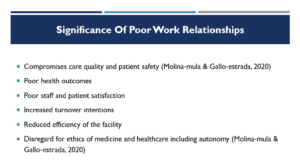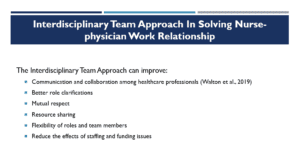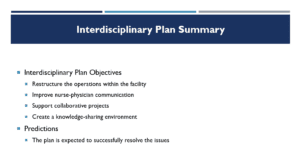Stakeholder Presentation-Interdisciplinary Team Approach
Hello, and welcome to this stakeholder presentation. This presentation will inform you of the planned implementation of an interdisciplinary team approach to solve some issues identified following an interview with the facility’s leadership. You will get to learn about the organizational issue and its significance. The presentation will also cover the implementation and evaluation process of the Interdisciplinary team approach and the roles of the interdisciplinary teams.
This presentation has five main sections. The first section will provide details on the organizational issue of focus. The next sections will cover the relevance of an interdisciplinary team approach in addressing the issue of concern, then the summary of the interdisciplinary plan. The next sections of the presentation will focus on the implementation of the interdisciplinary plan, resource management, and the evaluation of the plan.
The complaints from the local community and nurses over concerns about the deteriorating quality of health services provided in the facility led to the interview with the nurse leader of the facility. The family nurse practitioner (FNP) doubles as the medical center’s administrator and primary health care provider. The interview identified three issues of concern: a shortage of healthcare professionals, both nurses and physicians, poor nurse-physician work relationships, and limited resource funding. These issues seem to be largely interrelated. The poor funding seems to contribute to the shortage of healthcare professionals and the poor work relationships and vice versa. However, the poor nurse-physician relationship contributes to poor resource funding and the facility’s understaffing. These collegial relationships affect the work environment. A study by Cristina Gasparino et al. (2021) has linked the characteristics of the professional work environment for nurses to the impact on health outcomes, the effectiveness of nurse managers in supporting nursing and other care services, and the adequacy of resources and staffing. The poor work relationship between nurses and physicians is a major organizational issue of concern.
As described by the lead FNP, the nurse-physician relationships are visibly strained. The FNP noted that the nurses and physicians had strained communication based on the number of times they had to intervene. The poor nurse-physician relationships have led to poor resource sharing, affecting the ability of the facility to deliver needed patient and community care services at a time the resources are poorly funded. There have been visible conflicts between the nurses, which have further created tension and stress among the facility’s healthcare professionals leading to a total lack of collaboration during patient care. The dominance of physicians over nurses is thought to be a contributing factor to these poor nurse-physician work relationships.
The relationship between nurses and physicians is essential within hospitals and larger healthcare settings. When poor work relationships between nurses and physicians exist, they pose a risk to the quality and safety of care provided to patients (Molina‐mula & Gallo‐estrada, 2020). Strained work relationships also contribute to poor patient and community health outcomes as well as those of healthcare professionals. These relationships also contribute to poor satisfaction outcomes for both the patients and the staff. The reduced staff satisfaction is a factor for turnover intentions as well as reduced efficiency of the facility’s service delivery. Additionally, a poor relationship between nurses and doctors has been linked to the capacity to observe patient autonomy during decision-making (Molina‐mula & Gallo‐estrada, 2020).
Interdisciplinary team approaches are essential for improved patient and health outcomes. Interdisciplinary team approaches impact how various healthcare professionals relate during care delivery. As an interprofessional model, the approach is linked to improved collaboration and coordination of care within interprofessional teams (Walton et al., 2019). This approach to care delivery is linked to improved management of resources and ease of managing the staff and health organization. Furthermore, interprofessional models contribute to improved shared-decision making (Jeanne Wirpsa et al., 2018). All of these positively impact the efficiency and outcomes of the care process as well as the satisfaction of patients and the healthcare staff.
The interdisciplinary team approach is viewed as the most relevant approach to solving the current poor work relationships within the healthcare facility for several reasons. Firstly, based on research evidence, interprofessional teams improve communication and collaboration among healthcare professionals (Walton et al., 2019). Besides this, due to improved communication and collaboration, the interdisciplinary team approach is expected to improve the understanding of the roles of physicians and nurses and the importance of each distinct and interrelated role. This, in turn, is expected to improve respect among the nurses and physicians, resource sharing, and the flexibility of the roles of the nurses and physicians. This can also, in large part, reduce the effects of staffing and funding issues.
The proposed interdisciplinary plan has various objectives focused on improving the nurse-physician relationships to help resolve the other previously identified organizational issues. The plan will focus on restructuring how care processes within the facility are carried out. This will include creating a structure requiring strict collaboration between healthcare professionals. Additionally, the plan will focus on interprofessional communication education as well as the creation of a collaborative environment that supports communication and knowledge sharing among nurses and physicians. The plan is expected to successfully resolve the issues as a majority of the care professionals have expressed their interest in the proposed changes.
The interdisciplinary team will be required to perform their assigned roles collaboratively. The roles will include leading and managing resources within the facility, probing patients for their healthcare issues, and collaboratively setting patient health goals and outcomes. The nurse-physician teams will also be required to make shared decisions, with every individual having a chance to contribute to the decisions. Additionally, they are all expected to have shared responsibility for outcomes as well as the use of available resources.
The interdisciplinary plan will be implemented within the nurse and physician practice settings; therefore, the normal facility operations will not be disrupted. The plan will encourage peer-to-peer learning and strict face-to-face communication to ensure its success. For effective resource management, the plan will require the stakeholders to record all resources required or used during its implementation. The nurses and physicians share responsibility in resource management. They must ensure that the provided resources meet the daily facility operation needs. To ensure more effective resource management and reduce expenses during the implementation, a central resource and information management system will be set up and integrated into the current EHR system. Additionally, the plan integrates patients as key stakeholders responsible for managing patient-related resources.
The resource expenditure for the implementation of the proposed interdisciplinary plan is clearly justified. If the facility fails to implement the plan, the current issues of poor staffing, strained nurse-physician relationships, and poor resource funding will worsen. The exacerbation of these issues hinders the ability of the healthcare facility to deliver care to the local community as per its care objectives and its vision and mission to improve healthcare in rural communities. It should also be noted that the proposed interdisciplinary plan will mostly utilize the currently available resources within the facility. Therefore, the resource expenditure will remain at a minimum.
The plan will have various set milestones to ensure that it is working towards its main objectives. The key set measures for the plan’s evaluation include the reported experiences of the nurses and stakeholders, the reported levels of patient and staff satisfaction, and the efficiency of care services with a focus on the time taken to serve patients from the point of reporting to the point of discharge. Additionally, the evaluation will also consider the rate of resource utilization and the notable levels of collaboration and communication efficiency among the nurses and physicians.
In conclusion, it is clear that poor nurse-physician relations have negative outcomes on all aspects of healthcare, including safety and quality of care, patient health, and organizational outcomes. Implementing the Interdisciplinary team approach will improve the work relationship within the facility and help the organization meet its objectives. However, for the plan to be effectively implemented, it will require input for all stakeholders, especially the nurses and physicians. Lastly, the evaluation of the plan focuses on patient and facility outcomes.
Cristina Gasparino, R., Daiana Mendonça Ferreira, T., Ceretta Oliveira, H., Fernanda dos Santos Alves, D., & Pazetto Balsanelli, A. (2021). Leadership, adequate staffing and material resources, and collegial nurse-physician relationships promote better patient, professional, and institutional outcomes. Journal of Advanced Nursing, 77(6), 2739–2747. https://doi.org/10.1111/JAN.14805 Jeanne Wirpsa, M., Emily Johnson, R., Bieler, J., Boyken, L., Pugliese, K., Rosencrans, E., & Murphy, P. (2018). Interprofessional Models for Shared Decision Making: The Role of the Health Care Chaplain. Https://Doi.Org/10.1080/08854726.2018.1501131, 25(1), 20–44. https://doi.org/10.1080/08854726.2018.1501131
Our Advantages
- Quality Work
- Unlimited Revisions
- Affordable Pricing
- 24/7 Support
- Fast Delivery
Order Now
 The relationship between nurses and physicians is essential within hospitals and larger healthcare settings. When poor work relationships between nurses and physicians exist, they pose a risk to the quality and safety of care provided to patients (Molina‐mula & Gallo‐estrada, 2020). Strained work relationships also contribute to poor patient and community health outcomes as well as those of healthcare professionals. These relationships also contribute to poor satisfaction outcomes for both the patients and the staff. The reduced staff satisfaction is a factor for turnover intentions as well as reduced efficiency of the facility’s service delivery. Additionally, a poor relationship between nurses and doctors has been linked to the capacity to observe patient autonomy during decision-making (Molina‐mula & Gallo‐estrada, 2020).
The relationship between nurses and physicians is essential within hospitals and larger healthcare settings. When poor work relationships between nurses and physicians exist, they pose a risk to the quality and safety of care provided to patients (Molina‐mula & Gallo‐estrada, 2020). Strained work relationships also contribute to poor patient and community health outcomes as well as those of healthcare professionals. These relationships also contribute to poor satisfaction outcomes for both the patients and the staff. The reduced staff satisfaction is a factor for turnover intentions as well as reduced efficiency of the facility’s service delivery. Additionally, a poor relationship between nurses and doctors has been linked to the capacity to observe patient autonomy during decision-making (Molina‐mula & Gallo‐estrada, 2020).
 The interdisciplinary team approach is viewed as the most relevant approach to solving the current poor work relationships within the healthcare facility for several reasons. Firstly, based on research evidence, interprofessional teams improve communication and collaboration among healthcare professionals (Walton et al., 2019). Besides this, due to improved communication and collaboration, the interdisciplinary team approach is expected to improve the understanding of the roles of physicians and nurses and the importance of each distinct and interrelated role. This, in turn, is expected to improve respect among the nurses and physicians, resource sharing, and the flexibility of the roles of the nurses and physicians. This can also, in large part, reduce the effects of staffing and funding issues.
The interdisciplinary team approach is viewed as the most relevant approach to solving the current poor work relationships within the healthcare facility for several reasons. Firstly, based on research evidence, interprofessional teams improve communication and collaboration among healthcare professionals (Walton et al., 2019). Besides this, due to improved communication and collaboration, the interdisciplinary team approach is expected to improve the understanding of the roles of physicians and nurses and the importance of each distinct and interrelated role. This, in turn, is expected to improve respect among the nurses and physicians, resource sharing, and the flexibility of the roles of the nurses and physicians. This can also, in large part, reduce the effects of staffing and funding issues.
 The proposed interdisciplinary plan has various objectives focused on improving the nurse-physician relationships to help resolve the other previously identified organizational issues. The plan will focus on restructuring how care processes within the facility are carried out. This will include creating a structure requiring strict collaboration between healthcare professionals. Additionally, the plan will focus on interprofessional communication education as well as the creation of a collaborative environment that supports communication and knowledge sharing among nurses and physicians. The plan is expected to successfully resolve the issues as a majority of the care professionals have expressed their interest in the proposed changes.
The proposed interdisciplinary plan has various objectives focused on improving the nurse-physician relationships to help resolve the other previously identified organizational issues. The plan will focus on restructuring how care processes within the facility are carried out. This will include creating a structure requiring strict collaboration between healthcare professionals. Additionally, the plan will focus on interprofessional communication education as well as the creation of a collaborative environment that supports communication and knowledge sharing among nurses and physicians. The plan is expected to successfully resolve the issues as a majority of the care professionals have expressed their interest in the proposed changes.